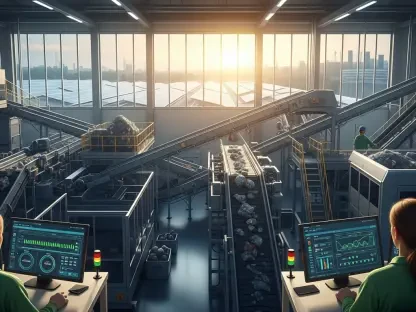In the heart of Europe, Germany’s industrial giants—think automakers crafting precision vehicles and steelmakers forging the backbone of infrastructure—are grappling with a silent crisis that threatens their survival. Energy bills have soared to levels that push these titans to the brink of losing their edge in global markets, and with production costs spiraling, a critical question emerges: can a bold government plan to subsidize electricity prices breathe new life into this struggling sector, or is it merely a fleeting reprieve for an economy under siege?
The Weight of Energy Costs on Germany’s Industrial Might
The importance of affordable energy for Germany, often hailed as the economic engine of Europe, cannot be overstated. High electricity prices have become a chokehold on industries that contribute significantly to the nation’s GDP—sectors like automotive, chemicals, and steel employ millions and drive innovation. Without a competitive cost structure, these companies risk losing ground to rivals in regions where power is cheaper, such as parts of Asia and North America.
This economic pressure has not gone unnoticed. The industrial downturn, marked by declining output and factory closures, has sparked urgent debates in Berlin about how to safeguard Germany’s role as a manufacturing leader. Energy costs, often overlooked in broader economic discussions, have now taken center stage as a make-or-break factor for the nation’s future prosperity.
Unpacking the Government’s Subsidized Power Initiative
In a decisive move, Chancellor Friedrich Merz’s coalition government has introduced a groundbreaking policy to cap electricity prices at 5 euro cents per kilowatt-hour for energy-intensive industries, a rate set to hold until 2028. This measure targets the heart of production costs, aiming to provide immediate relief to sectors struggling under financial strain. Alongside this, plans to expand gas power capacity by 8 gigawatts and slash aviation fees by 350 million euros ($408 million) signal a multi-pronged approach to economic stabilization.
Yet, challenges loom on the horizon. Securing approval from the European Union for state aid compliance remains a hurdle, though Merz has expressed optimism about nearing an agreement with the EU Commission. This initiative, while ambitious, is seen as a cornerstone of a larger strategy to reinvigorate industrial output and maintain Germany’s standing in global trade networks.
The scope of this policy reflects a recognition that short-term fixes must align with long-term energy security. By addressing immediate cost burdens, the government hopes to buy time for industries to adapt, though the effectiveness of this plan hinges on navigating regulatory complexities and ensuring sustained funding.
Voices from the Field: Industry and Expert Reactions
Not everyone views the subsidized power plan as a complete solution. Wolfgang Große Entrup, head of the VCI representing the chemicals sector, has described the policy as a “step in the right direction” but insufficient on its own. He argues that deeper issues—such as heavy taxation and bureaucratic red tape—continue to stifle growth, urging a more comprehensive overhaul to truly level the playing field.
Economic analysts echo this cautious optimism. Many point out that while the price cap could lower operational costs by up to 20% for some firms, based on current energy consumption data, it does little to address structural inefficiencies that have plagued German industry for years. The consensus seems to be that temporary relief must be paired with systemic reform to compete with global powerhouses like China and the United States.
A case in point is the automotive sector, where executives have noted that cheaper power helps but does not solve supply chain disruptions or the rising costs of raw materials. This diversity of feedback underscores a critical reality: energy subsidies are a vital piece of the puzzle, but not the entire picture.
Leveraging the Policy for Maximum Impact
To make the most of this subsidized pricing scheme, industries must act strategically. Companies can start by auditing their energy usage to optimize consumption under the new rates, potentially reinvesting savings into innovation or workforce training. Advocacy for additional reforms, particularly in reducing tax burdens, could amplify the policy’s benefits over the coming years.
On the government’s side, building on this initiative requires a focus on sustainable energy solutions. Investing in renewable energy infrastructure and streamlining administrative processes could ensure that the industrial sector not only survives but emerges stronger. Policies that incentivize energy-efficient technologies might also help firms reduce dependency on subsidies in the long run.
Collaboration between public and private sectors appears essential. Joint efforts to pilot new energy models or fast-track regulatory approvals could set a precedent for how Germany tackles industrial challenges, ensuring that the current relief translates into lasting competitiveness on the world stage.
Reflecting on a Pivotal Moment for German Industry
Looking back, the rollout of subsidized power at 5 euro cents per kilowatt-hour marked a defining chapter in Germany’s battle to preserve its industrial legacy. It was a calculated gamble to ease the burden of crippling energy costs, coupled with efforts to bolster gas power and support aviation. Industry voices, while appreciative, consistently highlighted the need for broader reforms beyond mere price caps.
The path forward demanded more than temporary fixes; it called for a unified push toward innovation in energy and policy. Stakeholders were encouraged to seize this moment—industries to adapt and optimize, and policymakers to pave the way for sustainable growth. Only through such concerted action could Germany hope to reclaim its competitive edge in an ever-evolving global market.









